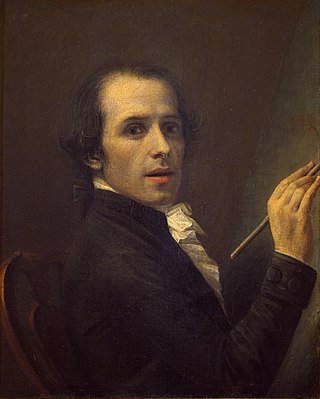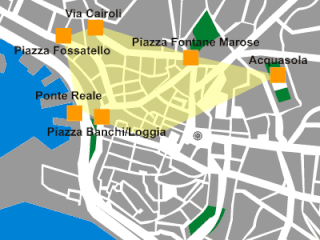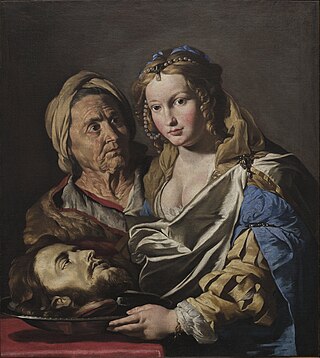
Antonio Canova was an Italian Neoclassical sculptor, famous for his marble sculptures. Often regarded as the greatest of the Neoclassical artists, his sculpture was inspired by the Baroque and the classical revival, and has been characterised as having avoided the melodramatics of the former, and the cold artificiality of the latter.

Il Cannone Guarnerius of 1743 is a violin created by the Italian luthier Giuseppe Bartolomeo Guarneri of Cremona (1698–1744).

Palazzo Bianco is one of the main buildings of the center of Genoa, Italy. It is situated at 11, via Garibaldi.
Massimo Sacchetti is an eclectic contemporary Italian artist from the Italian Alps of Aosta Valley, Italy and has exhibited over the years in various important locations in Italy, Finland, Great Britain, the United States, Germany and France. He is a Lecturer at the Art School of Aosta and he has been collaborating for years with numerous art and design institutes.

The Palazzo Brignole Sale or Palazzo Rosso is a house museum located in Via Garibaldi, in the historical center of Genoa, in Northwestern Italy. The palace is part of the UNESCO World Heritage Site Genoa: Le Strade Nuove and the system of the Palazzi dei Rolli. The rich art collection inside, along with the galleries of Palazzo Bianco and Palazzo Doria Tursi, is part of the Musei di Strada Nuova and consists of the works of artists of the caliber of Antoon van Dyck, Guido Reni, Paolo Veronese, Guercino, Gregorio De Ferrari, Albrecht Dürer, Bernardo Strozzi and Mattia Preti.

Genoa: Le Strade Nuove and the system of the Palazzi dei Rolli is a UNESCO World Heritage Site which includes a number of streets and palaces in the center of Genoa, in Northwestern Italy.
Carlo Doria, 1st Duke of Tursi was a Genoese general who fought for Spain during the War of Mantuan Succession.

The Museo di Roma is a museum in Rome, Italy, part of the network of Roman civic museums. The museum was founded in the Fascist era with the aim of documenting the local history and traditions of the "old Rome" that was rapidly disappearing, but following many donations and acquisitions of works of art is now principally an art museum. The collections initially included 120 water-colours by the nineteenth-century painter Ettore Roesler Franz of Roma sparita, "vanished Rome", later moved to the Museo di Roma in Trastevere.

Genoa is a city in and the capital of the Italian region of Liguria, and the sixth-largest city in Italy. In 2023, 558,745 people lived within the city's administrative limits. While its metropolitan city has 813,626 inhabitants, more than 1.5 million people live in the wider metropolitan area stretching along the Italian Riviera.

Maddalena is a neighbourhood in the old town of the Italian city of Genoa. It was one of the six sestieri of ancient Genoa. At present it is part of the Genoa's city Municipio I.

The Cervara Altarpiece or Cervara Polyptych was an oil-on-oak-panel altarpiece painted by the Flemish painter Gerard David early in the 16th century for the high altar of Cervara Abbey in Liguria, Italy.

Salome with the Head of John the Baptist is an oil on canvas painting by the 17th century painter Matthias Stom. It is now in the Palazzo Bianco of the Musei di Strada Nuova in Genoa, to whose collections it was left in 1926 by E. L. Peirano. Typically of the painter's style, it combines Flemish attention to detail with the lessons he had learned from Caravaggio's work.

The Penitent Magdalene is a marble sculpture of Mary Magdalene by Antonio Canova, about 90 cm high, known in two final versions, now in Genoa and St Petersburg.

Woman Cooking or The Cook is the modern title given to a circa 1625 oil on canvas genre painting by Bernardo Strozzi, produced in Genoa and still held in the Palazzo Rosso in the city, part of the Strada Nuova Museums. A second autograph version with various differences was in the painter's studio at his death and is now at the National Gallery of Scotland in Edinburgh.

Maria Brignole Sale De Ferrari, Duchess of Galliera was an Italian noblewoman and philanthropist. She enabled the foundation of the first museums in her birthplace of Genoa, the Palazzo Rosso and Palazzo Bianco as well as the Galliera Hospital and the San Filippo children's hospital. A statue of her by Giulio Monteverde stands in the hospital gardens.

The palazzo Doria-Tursi or palazzo Niccolò Grimaldi is a building on Via Giuseppe Garibaldi in the historic town centre of Genoa. With Palazzo Rosso and Palazzo Bianco it houses the Strada Nuova Museums and on 13 July 2006 all three palaces and the streets around them became the Genoa: Le Strade Nuove and the system of the Palazzi dei Rolli World Heritage Site. Since 1848 Palazzo Doria-Tursi has also housed the city hall of Genoa.

Madonna and Child with Saints is a c. 1520-1522 oil on panel painting by Palma Vecchio, now in the Palazzo Rosso in Genoa.

The Dying Cleopatra or The Death of Cleopatra is a c. 1648 oil on canvas painting by Guercino, now in the Palazzo Rosso in Genoa.

Giovanni Ponzello was an Italian mannerist architect active in the Republic of Genoa, where he supervised the construction of several distinguished palaces and churches during the Renaissance period.


















